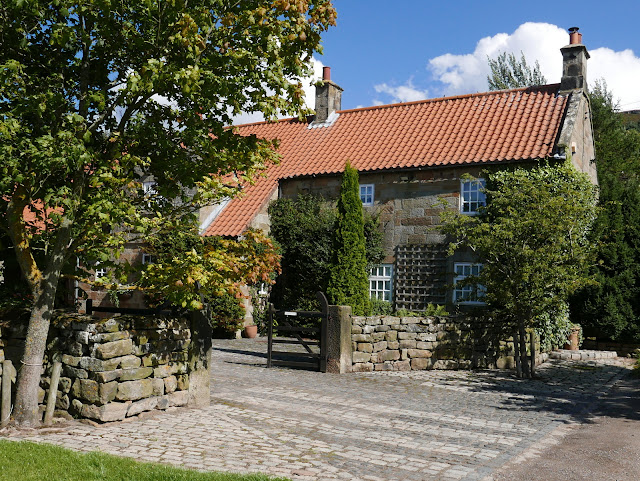Bank Foot to Upper Baysdale
and Burton Howe
11 miles Sunny and warm
 |
| Battersby Junction from Turkey Nab |
 |
| Step over the chain to follow the moor path |
 |
| The view east from Turkey Nab |
Just beyond the Nab we turned left onto a smaller track that leads across Ingleby Moor, crossing Black Beck about a mile further on before a slight climb to bear left onto Middle Head Road. The heather is now at its finest and there was a tremendously strong smell of pollen. Bees and other insects were everywhere but not interested in us.
 |
| Starting to cross Ingleby Moor |
 |
| Through walls of heather |
 |
| This year's display is the best we've seen |
 |
| Descending to Black Beck |
Shortly after crossing Black Beck we came to an interesting group of large boulders known as the Cheese Stones, a good vantage point for looking down into Baysdale. We walked over to have a better view.
 |
| The Cheese Stones |
 |
| B Close has added his name to Maurice's in 1952 |
 |
| Looking towards Baysdale from the Cheese Stones |
 |
| More of Maurice's graffiti by the look of it, though neatly done! |
Continuing along the moor we came to the remains of a medieval cross and a little more walking found us looking down onto the imposing building of Baysdale Abbey Farm.
 |
| Remains of old cross |
 |
| Abbey Farm in the distance |
We walked down through to reach a gate into Intake Plantation and were soon walking through the trees to reach a fine view down to Baysdale Abbey. We found a comfortable mound of grass to sit on and enjoy our coffee and scones in the sun.
 |
| Intake Plantation |
 |
| A fine view to Baysdale Abbey and beyond |
 |
| Time for a coffee break |
We finished our coffee and walked down to the Abbey and its farm buildings.
 |
| Baysdale Abbey, west side |
 |
| Baysdale Abbey, east side |
Tom Scott Burns explains that in the middle ages land rents for Baysdale were paid with the heads of wolves, which were numerous in the area, and one can imagine this wild enclosed ravine in the 1300s, when cattle were over-wintered in the valley bottom. In fact, TSB explains, Baysdale is derived from Basdale meaning Cow Shed Valley. The Abbey Farm has been renovated and is now marketed as holiday lets and we walked round the building, then followed the yellow way-marks uphill to Thorntree House.
 |
| Approaching Thorntree House |
 |
| Thorntree House |
We passed Thorntree House and climbed through the plantation to reach Baysdale Moor and as TSB relates, " an ever-unfolding sea of moorland". Purple heather was to be seen in every direction and the smell of its pollen was very heady. We followed the moorland track for about 1.5 miles, turning right just before reaching an old stone shooting box. Considering the season we saw very few grouse and wondered if there has been a problem with bird numbers this year.
 |
| A sea of purple heather in every direction |
 |
| Looking back towards Baysdale |
 |
| Ingleby and Stoxley, and hand pointer |
 |
| Kirby and Helmsley 1757 |
 |
| Coins for the needy! |
We now had a two mile walk along the escarpment with fine views, purple heather to our right and the villages of Cleveland below us to the left. We were so immersed in this amazing view that it was some time before we we became aware of a rumbling noise and found ourselves slowly overhauled by a group of off road vehicles. They trundled past us and then as the going got tougher they slowed to a crawl and we trundled past them. In the end we saw the drivers get out of their vehicles to look at the enormous ruts and they were still standing there as we walked back down Turkey Nab. We think they would have to reverse quite a way before they could turn round. Ha!
 |
| Heather to our right... |
 |
| Ingleby Hall below |
 |
| A traffic jam on Turkey Nab |
 |
| We walk back down to Bank Foot |
Alfred J Brown in his book Tramping in Yorkshire, says, "Even the longest ridge must come to an end, and suddenly the road twists, hesitates, and takes the plunge gloriously down Turkey Nab. The Cleveland County is full of 'Nabs' but Turkey Nab will take some beating."
Back at Bank Foot we stopped to stroke a couple of horses and their foal who remained shyly behind its mother, before driving the short distance to Great Ayton and the Royal Oak for a cooling pint.
 |
| "Let's see your foal?" |
 |
| Re-assuring nuzzle |





































































































